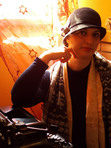Dixieland (AtoZ Challenge 2016 – Jazz Age Jazz)
JAZZ AGE JAZZ - Dixieland #AtoZChallenge #jazz The sound of âcollective inprovisationâ
Click To Tweet
Although pin-pointing where exactly jazz originated is quite a difficult undertaking, it is generally accepted that early jazz appeared as a recognizable music in and around New Orleans at the turn of the XX century.
New Orleans was the ideal place to produce the kind of multi-influenced music that jazz is. A the turn of the XX century, New Orleans was home to many different cultures that clashed, but also met in a multicultural environment. Many languages were spoken in the city, French, Spanish and English being the prominent. There was a strong Caribbean influence that prompted a high tolerance toward the black community, which allowed slaves to retain much of their culture. Each of these differetn culture brought something to the table of music, but the Creaoles in particular
 Louis Armstrong
Louis Armstrongunited in themselves most of these characteristics.
Hig-brow music and low-calss music cohexisted in New Orleans and sometimes crossed path. It was an extraordinarily ripe mix of oral music techniques of lower-class origins, that by merging with a more formal concept of music adapted itself to the new demands of the professional dance halls.
Jazz, this new music, came of age in New Orleans, and when jazzmen left the South and moved North on the tracks of the Great Migration, this music became known as Dixieland.
Dixieland instrumentation and band size could be very flexible but primarily consisted of a âfront lineâ (trumpets or cornet, trombone and a clarinet) and a ârhythm sectionâ (guitar or banjo, bass or tuba, piano and drums). It very much resembled the organization of marching bands in New Orleans, which were probably the firsts to perform Dixieland.
The defining Dixieland sounds is the âcollective improvisationâ. This happens when one instrument â usually the trumpet â plays the melody or a recognizable paraphrase or variation of it and the other instruments of the âfront lineâ improvise around that melody.
It creates a music that is always evolving and may even sound chaotic at first. In fact, in the 1920s, many people didnât even consider jazz to be proper music. Thomas Edison famously commented that it sounds better when played backwards.
Still a lot of people did get the gist of it. In the 1920s, Dixieland was probably the most popular form of jazz.
————————————————————————————————————————————–
RESOURCES
About Entertainment – What is Early Jazz?
Prezi – Dixieland
QuizLet – Dixieland and Early Jazz/Blues from New Orleans
Gonola – Dixieland Jazz: Innovator in New Orleans music history
New World Encyclopedia – Dixieland
Smashwords | Barnes&Nobles | Kobo | iBookStore
And many other stores
The post Dixieland (AtoZ Challenge 2016 – Jazz Age Jazz) appeared first on The Old Shelter.






